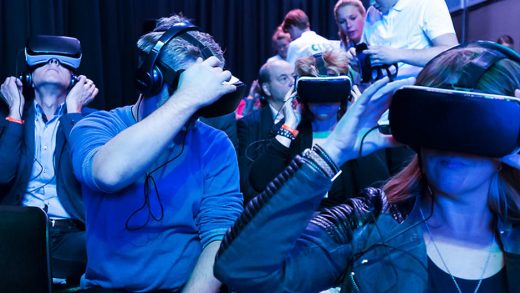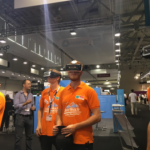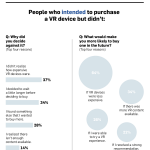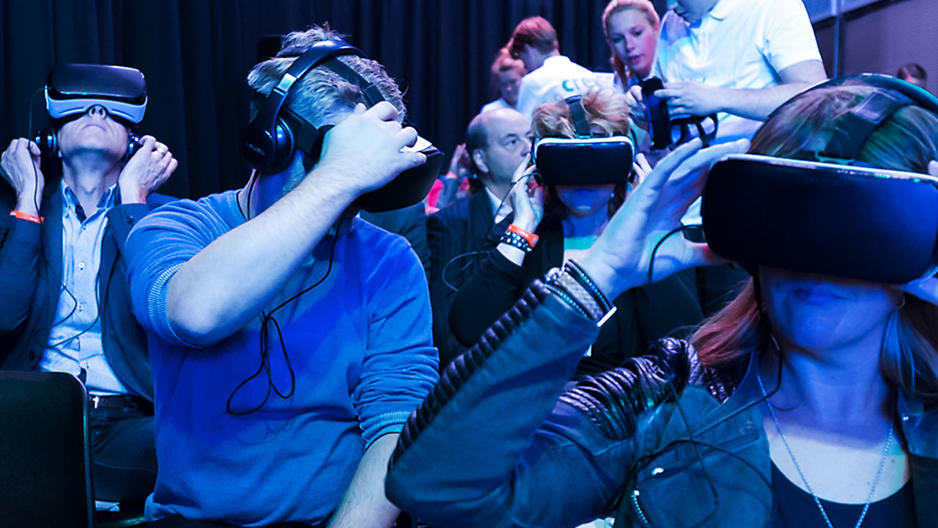Why I Can’t Wait To Work In VR
Startups run into countless problems, but my company recently hit one plenty would consider themselves fortunate to have. We spent millions renovating our office to accommodate up to 185 people, the highest headcount we thought we’d ever hit. Less than a year later, we now have 160 staffers and are looking at costly expansion options—at a cost of several million more.
But what if we didn’t have to pay that price, or could at least reduce it? Vidyard is in the video industry, and as its CEO and a pretty big tech nerd, I’m especially drawn to virtual reality. So I started to wonder if there’d ever come a point when our office could ditch physical walls and open up virtual workspaces instead?
For now, the answer is a definitive no. We keep hearing how VR is changing gaming, entertainment, and even marketing. But real VR innovation has yet to hit the modern workplace. Even early adopters are hard to find.
But that doesn’t mean the potential isn’t real, or that we don’t have a pretty good sense of what it might look like when VR really does come to the office. And based on that forecast, at least, the obstacles seem to me to pale in comparison to the benefits. Here are a few of them that I’m looking forward to.
Virtual Reality, Real Advantages
In tech-supercharged San Francisco, office rents passed Manhattan as the most expensive in the U.S. this year, at $72.26 per square foot. In fact, the cost of physical space is pushing more startups out of traditional hubs in the Bay Area, New York, and Seattle. Having virtual “office space” would slash this enormous line item out of the budget, freeing up funds to invest in growth and human talent. It’s hard to overestimate how transformative this could be.
The virtual workplace could also revolutionize employee engagement and retention, the single biggest human capital concern identified by a Deloitte survey across 106 countries last year. This isn’t mere speculation; at my company, we’ve already started to see some of the benefits that remote-work technology has already created, even without virtual tools.
While our offices are outside Toronto, our executive team is scattered across North America. So we’ve put Google Chromeboxes in every meeting room and added Google video Hangouts to all our meeting invites. Yes, the tech is still pretty clunky, but it lets us tap a level of talent that would otherwise be unavailable in our home base. With full VR, the experience would be even more seamless.
Related Video: Take Flight with This Full Body VR Experience
Some office-politics issues could be erased as well. As an introvert, I find it’s difficult in my office to find a few moments alone to get work done without interruption. With VR, it’s possible to join in social settings like meetings but keep control over when to engage and when to unplug. Since you’re not actually there, there’s no busy, distraction-riddled office space for you to escape from.
Of course, this is just the tip of the iceberg. When physical space is deprioritized and employees can live anywhere, all kinds of pressures can be relieved. We’d no longer have to cram into cities, which could reduce housing costs and reverse the kinds of gentrification that so many tech centers beget. Workers would no longer have to commute into the office each day with potentially huge environmental upsides, and thus might relieve the need for massive government spending on infrastructure.
Plus, less commuting and more efficient workplaces might even mean more time to spend offline—with friends and family, in quaint, old non–virtual reality. Sure, we’ve been hearing forecasts of a future with ever more leisure time since at least Keynes, but it’s not hard to envision the kind of virtuous cycle that a VR workplace could set in motion.
Not Yet Ready For Liftoff
If VR has so much revolutionary potential, why aren’t workplaces embracing it already? For starters, the technology isn’t good enough yet. From plenty of firsthand trial and error, I can confirm that the headsets are too bulky to wear on your head all day, or even through a meeting lasting more than an hour. The screen resolution on popular models is generally too grainy, and the associated apps and tools for the office are all still in their infancy.
Facebook has made some headway here, though. In October, Mark Zuckerberg demonstrated to Oculus developers his company’s ideas for social interaction via VR, featuring avatars that could show facial expressions and other details. When combined with a platform like AltspaceVR, people could use these avatars to meet inside realistic virtual environments in order to work or socialize.
Those changes are already coming—the question is when. And in the meantime, augmented reality (AR) is offering a stand-in for full VR. With AR, you’re not digitally re-creating a scene but adding digital elements to the real world. Thyssenkrupp plans to use Microsoft’s Hololens to enable technicians to visualize an elevator-repair job before they arrive onsite, for example. IKEA is already using AR to help customers visualize how furniture might look in their homes. It’s only a matter of time before these tools are workplace-ready.
But it may not matter how far along the technology is if companies aren’t ready to embrace it. It was only three years ago that Yahoo famously started an uproar when it ordered its remote workers back to the office. This wasn’t a technological issue as much as an old-fashioned prejudice against remote working that may be expanding in practice faster than it’s gaining popularity.
Fears are often as vague as they are unfounded, though—the worry that people will slack off if left unsupervised, that the camaraderie of an office can never be re-created digitally, and so on. In fact, as VR improves, efficiency and productivity may well improve with it. In a virtual environment, we’ll have access to instant information. We’ll be less likely to squander time racing to meetings—there’ll be nowhere to race to. To some extent, we may even be freed from some of the worst aspects of petty office politics—and, as some experts claim, even racial prejudice.
But for VR offices to truly take root, organizations need to get over their existing hangups and start normalizing the processes—right now—that make remote work possible. That’s a cultural matter, not a technological one. At Vidyard, for example, there’s a clear understanding that remote work is just as valued as in-person work. And we do simple things, like ensure every meeting invitation includes a link to a video Hangout. These are small steps, but they’re moving us steadily in the right direction.
VR’s benefits may seem like science fiction, or even utopian: affordable homes, roads free of cars, and employees merrily working wherever they want with more free time on the side. The actual future promises to be messier, less idyllic, and shaped by circumstances (and technologies) we can’t possibly envision.
Then again, much of what we do now on the internet—shop, socialize, access endless libraries of information—seemed equally utopian just a few decades ago. And while the internet is a very far cry from a digital utopia, there’s no denying some of the most transformative good things it’s enabled.
For my money, far more than autonomous cars or even the Internet of Things, the virtual workplace is poised to reshape the way we live in the years ahead. That’s a reality I can’t wait for.
Michael Litt is cofounder and CEO of the video marketing platform Vidyard. Follow him on Twitter at @michaellitt.
Fast Company , Read Full Story
(68)














